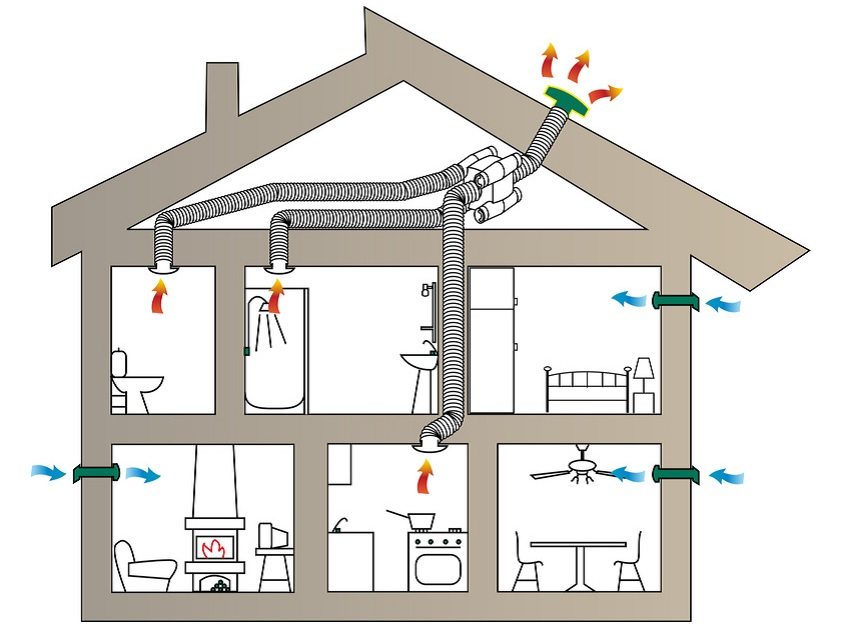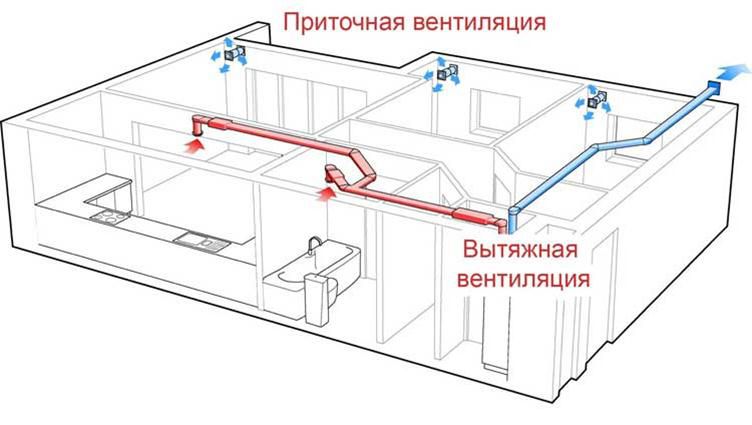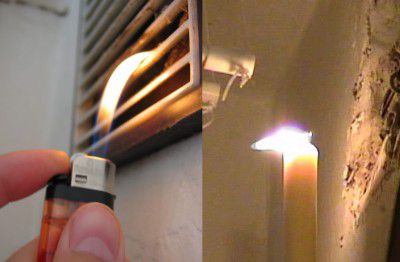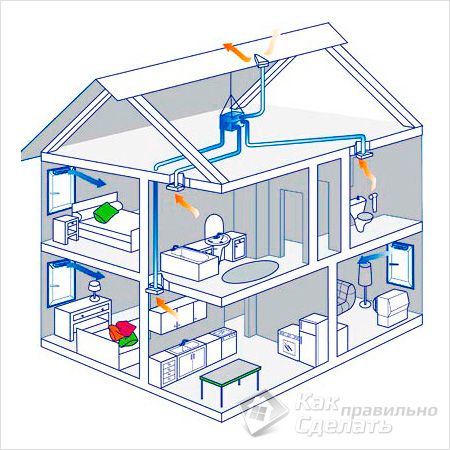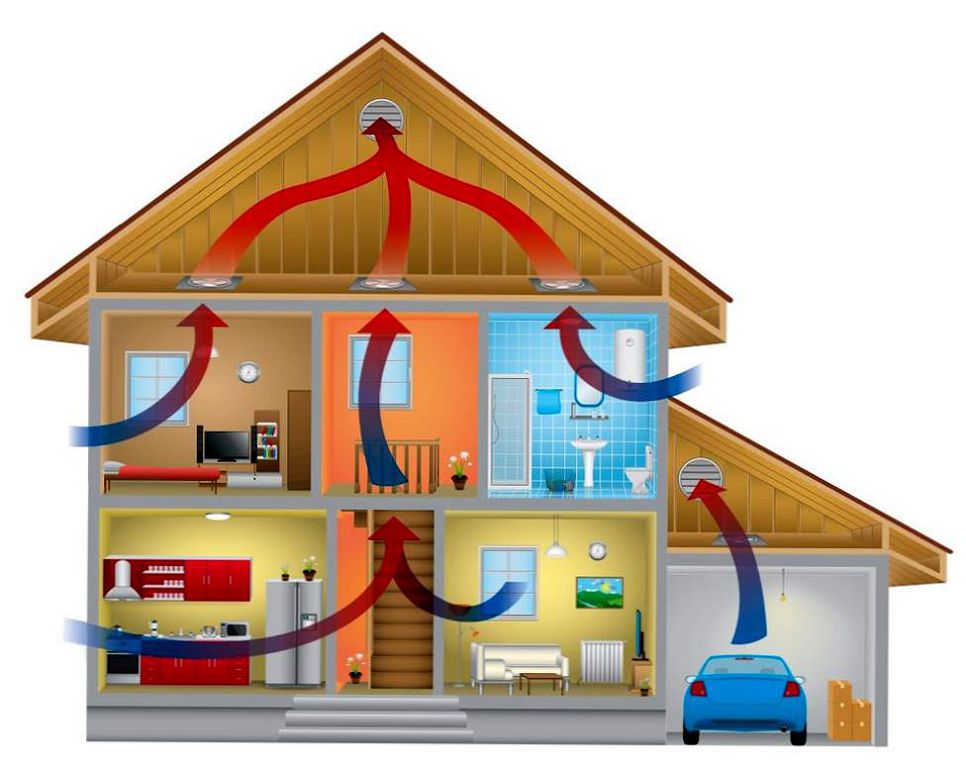Living in a house built of wood means enjoying the comfort and peace. Such a house keeps in itself the smells of the forest, it saturates you with the positive energy of nature. But to make it even easier to breathe in it, arrange efficient ventilation in a wooden house with your own hands. Then your home will become truly comfortable. Understanding how to make ventilation in a wooden house will give you the determination to get down to business as soon as possible.
Is ventilation really necessary in a wooden house?

Many times we have heard the statement that the tree "breathes". Repeatedly they remembered with a kind word the Russian stove, which, they say, served as a natural ventilation in the hut. All this is true, but only applicable to old peasant huts. There really was no need for any kind of ventilation in a wooden house, because already it was coming through from all the cracks.
A modern wooden house is quite another matter. What a "breath" of wood here, when the walls are made of laminated veneer lumber! For builders, the main task is to keep warm and prevent drafts, so the house looks like a tightly closed wooden chest. But the lack of air flow leads to the fact that natural ventilation in a wooden house does not work and the air stagnates.
That is why the question of whether ventilation is needed in a wooden house can be considered incorrect.
Of course, in a house made of wood, like in any other, it is necessary to equip a ventilation system. Which type of system you choose - natural or forced - is up to you, based on the specific conditions of your home.
Do-it-yourself ventilation device in a wooden house
Suppose that you yourself were engaged in the construction of your cottage, or at least took part. Consequently, you have gained experience in carrying out construction and installation work, and ventilation in a wooden house with your own hands will not seem to you too difficult a technological task. Let's also assume that you have some locksmith and carpentry tools stored in your closet. Therefore, we will not teach you how to hold them in your hands, but let's go straight to the point and consider the main points of the ventilation device in a wooden house.
The whole range of activities must be divided into several stages.
First, you need to design the ventilation system in your wooden house in such a way that its performance meets the approved standards.
Air exchange rates in various home premises:
| Kitchen with gas hob | 70 m³ / hour |
| Kitchen with electric stove | 50 m³ / hour |
| Bathroom | 30 m³ / hour |
| Bathroom | 50 m³ / hour |
| Living room | 30 m³ / hour |
| Utility room | 15 m³ / hour |
Only based on the results of sound design will you be able to accurately determine the necessary parameters of the ventilation system, taking into account the layout of your house.
Secondly, equip the ventilation ducts and install the air ducts in accordance with the diagram you have drawn up. By the way, a professional designer will help you to plan and draw the most correct ventilation scheme in your wooden house, if you deem it necessary to contact him.
Thirdly, check the performance of individual elements and the entire ventilation system as a whole, and if deficiencies are found, try to fix them.
Natural ventilation of a wooden house
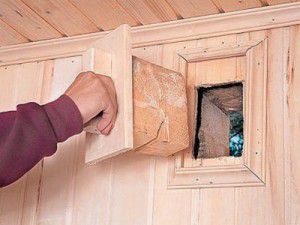
The natural ventilation system in a wooden house is attractive for its comparative cheapness and simplicity of the device. The movement of air occurs due to the tendency of the warm air mass to rise upward along the vertical channels specially constructed for this. Therefore, for you, natural ventilation in a wooden house with your own hands may be the most easily feasible, and at the same time quite effective.
To arrange ventilation in a wooden house, start from the basement, since it is here that the air from the outside must first penetrate. Under normal conditions, the ventilation of the foundation of a wooden house occurs through the so-called air vents. These small vents should be placed under each wall of the house during construction.
The air supply through the supply duct must be arranged at the level of the base. It is best on the north side of the house, where the air is coolest, and this is useful for increasing draft. It is not necessary to equip each home room with a separate supply duct. It will be enough to leave gaps of one and a half to two centimeters under all internal doors, and through them fresh air will spread everywhere. The exhaust air will naturally be forced out through the exhaust ducts, the entrances to which must be arranged under the ceiling of each room and covered with decorative grilles. The exit of each of the ventilation ducts must be raised as high as possible above the level of the roof.
Equip the ducts for the passage of air with valves or plugs, closing which, you will be able to regulate the rate of air exchange.
When you arrange natural ventilation in a wooden house with your own hands, make separate ventilation ducts for each type of room. That is, one channel for the kitchen hood, another for the bathroom, the third for the bedroom, etc. It is, of course, tempting to make one single roof pass instead of four. It will seem to you that this will save money and effort when installing ventilation in a wooden house, but it is unlikely to be useful. Indeed, with a strong wind in the exhaust duct, reverse thrust may occur, and then, for example, smells from the sewer will penetrate into the rooms.
In addition to atmospheric phenomena, other factors also affect the traction force in the ventilation duct:
- the height of the ventilation pipe;
- the size of the inner opening of the channel;
- number and configuration of turns,
- the presence of thermal insulation of the hood.
Consider these points when you install ventilation in a wooden house.
In addition, in summer, there is a minimum temperature difference between the lower and upper points of the ventilation duct, so there is almost no draft. In these conditions, it will be necessary to arrange ventilation through open windows more often.
So that the air flow does not encounter obstacles when passing through the ventilation duct, its inner surface should be smooth and not have any narrowings at the joints.
In a small wooden house, it is not necessary to build ventilation shafts made of bricks. This work is laborious, and in addition, dust will accumulate on the rough surface of the channel. When deciding how best to make ventilation in your wooden house, opt for smoother metal or plastic duct blocks.
When you carry out the ventilation device in a wooden house with your own hands, do not forget that the space under the roof also needs air circulation. If the uppermost room is built as a residential attic, it must be equipped with the same ventilation as in other rooms.And if the attic is uninhabited, then its ventilation should be carried out through special equipped holes in the roof.
Forced exhaust ventilation in a wooden house
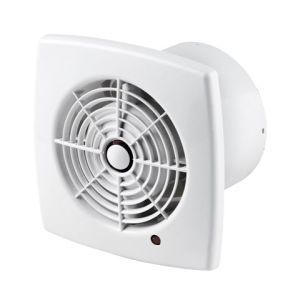
It often happens that the natural flow of air does not have time to refresh the atmosphere in the home. Then the owner thinks about whether enhanced ventilation is needed in a wooden house? You can complement the system by installing an electric fan, which will increase the power of the hood. Install it at the mouth of the exhaust duct exactly in the room where, according to the ventilation scheme in a wooden house, increased air exchange is required. For example, in the kitchen or in the bathroom.
Choose a fan in accordance with the diameter of the ventilation duct in which it is to be installed. Keep in mind that the power of the fan must be sufficient for the ventilation system in the wooden house to provide effective exhaust in each specific room. If it turns out that the fan is too weak and does not cope, you can also install a fan to help it blow outside air.
When installing the fan, connect it to the light switch in the bathroom, then it will stop simultaneously with the extinguished light.
In the case of forced exhaust, as with natural ventilation, it is not recommended to combine the exhaust from different rooms into one ventilation duct.
Supply ventilation of a wooden house
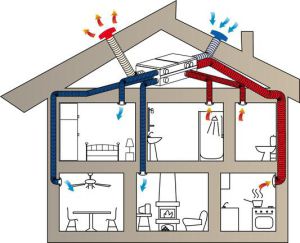
In addition to natural ventilation in a wooden house and the use of an exhaust fan, there is a more efficient way to refresh the air. Equip your supply ventilation system, which is also able to provide a reinforced exhaust. Such a device will provide a full-fledged air exchange throughout the home, from the ventilation of the foundation of your wooden house to the attic.
Supply ventilation solves several practical problems at once:
- fresh air supply from outside;
- filtering the supplied air and cleaning it from dust;
- heating the air flow passing through the channel;
- removal of polluted air outside the premises.
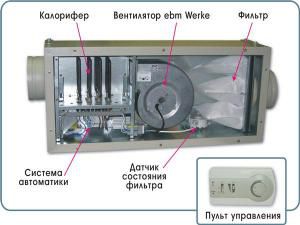
There are many types of equipment for ventilation systems in a wooden house from different manufacturers. To find out which one will be most useful for you, ask for advice when buying.
You can purchase the entire set disassembled and do the ventilation device in a wooden house with your own hands. But if you order the individual elements of the system already assembled, it will make your work easier.
A set of equipment for supply ventilation may include:
- duct fan providing air flow from outside;
- electric heater for air heating in winter;
- humidifier of too dry summer air;
- a noise damper to suppress vibrations from a running fan;
- filters that prevent dust from entering the system.
In addition, the system can be equipped with automatic control and monitoring.
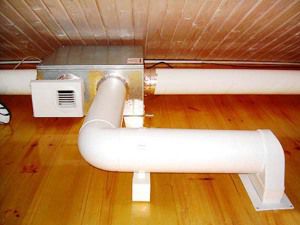
In order to protect the floors from vibration and the risk of fire, it is necessary to install the units on a low podium. In the process of installing ventilation in a wooden house, make the air supply and exhaust routes hidden in the ceilings and under the ceiling.
When installing system elements, do not forget to check the instructions attached to them.
You will need to do the routing of the air ducts in accordance with the pre-drawn diagram. The main design importance is that the distance from the air exhaust points under the ceiling of each room to the ventilation unit in the attic should be as small as possible.The air ducts themselves can be metal or plastic; it is convenient to make their connections from flexible corrugated pipes.
Do-it-yourself ventilation in a wooden house will be effective if you make a channel for the intake of fresh air in the pediment of the house, and take the outlet through the roof. Although for natural ventilation it is desirable that the supply pipe is located as low as possible, this is not critical for a forced system. On the contrary - the higher the inlet is from the ground, the less dust will get into it.
The diameter of all air ducts must be the same in order to prevent braking of the air flow at the joints.
Supply ventilation with recuperation
This system is a variation of conventional forced ventilation. Do you need such ventilation in a wooden house, in which the frosty winter air will be heated, but the energy consumption for heating will be minimal? Probably needed. Then the recuperator will help you to fulfill your wishes. This unit acts on the principle of a heat exchanger, it heats the incoming air due to the heat of the removed air mass. In this case, both streams are not mixed.
In summer, the recuperator can work in tandem with an air conditioner and partially cool the air passing through it due to the already cooled room atmosphere.
Checking the ventilation of a wooden house
It doesn't matter what kind of natural or forced ventilation in a wooden house you installed with your own hands, it should work effectively. To accurately check the performance of the ventilation system, there is an anemometer measuring device. But you can do with improvised means.
Take a piece of thin tissue paper and hold it up to the grille of the ceiling exhaust vent. In this case, the supply channel (or window) must be open. If the hood works, a piece of napkin will react to the movement of air and will be pulled to the mouth of the ventilation duct. In the same way, the airflow can be determined by the flame of a burning candle.
Do not try to check old ventilation ducts overgrown with cobwebs and dust with an open flame in order to avoid a fire!
In the future, try to pay attention to whether condensation appears on the windows in cold weather, whether mold has started in the corners, whether the walls are damp. These signs will signal to you that it is time to do preventive cleaning of the ventilation system.
Finally, we suggest watching a video that will help you understand the importance of ventilation in a wooden house.
We hope that you figured out how to make ventilation in a wooden house, and have already taken steps to translate the theory into reality. It's not so difficult as it seems at first. The main thing is to choose the right type of ventilation system and calculate its performance, as well as carefully mount all its structural elements. And as a result, you will find excellent well-being thanks to the constant freshness of the air in your home microclimate.


